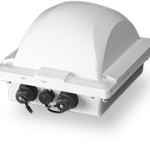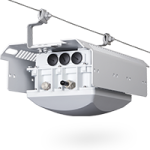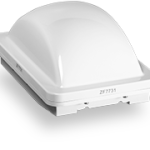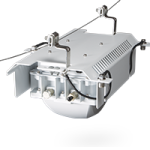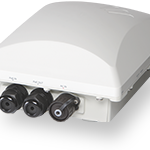The most robust 802.11n Outdoor Wi-Fi Access Point available, delivering range, reliability with Adaptive Antenna Technology custom fit for service providers
The Ruckus ZoneFlex 7762-AC and 7762-S-AC are the industry’s first 802.11n outdoor access points featuring purpose built capabilities for the service provider market such as a single mode fiber uplink, AC power, and up to 500 clients per AP. The 7762-S-AC features a long-range, high-gain sectorized smart antenna array that integrates adaptive antenna technology and unique interference mitigation technology to deliver up to an additional 6dB of BeamFlex gain, physical antenna gain of 10dBi, and 15dB of interference mitigation within in a 120° azimuth. This advanced smart Wi-Fi design with concurrent 802.11n radios delivers 150 Mbps of sustained throughput between mesh APs 600 meters apart and 50 Mbps of sustained throughput to clients 300 meters away.
The ZoneFlex 7762-AC is perfect for providers looking to quickly and economically expand branded broadband services, offload data traffic from congested 3G networks, deploy multimedia hotspots or offer wireless broadband services where fixed line access is limited. Concurrent 2.4/5GHz 802.11n radios for access and backhaul traffic deliver high-throughput to clients.
A directional antenna array and expert QoS software optimize delay-sensitive, IP video and high-density voice over Wi-Fi (VoFi) applications and PoE output allows connecting other devices such as an IP camera. Integrated Smart Mesh Networking technology automates deployment and eliminates running expensive cables to every outdoor AP.
The ZoneFlex 7762-AC can be deployed as a standalone AP and managed individually, or centrally managed by the ZoneDirector Smart WLAN controller or through the FlexMaster remote Wi-Fi management system as part of a unified indoor/outdoor wireless LAN. The Ruckus ZoneFlex 7762-AC simply plugs into any Ethernet network and is automatically discovered by the ZoneDirector.
Feature :
Purpose built for the carrier market
- AC power capabilities
- Single mode fiber uplink node option
- 500 clients per AP
Integrates BeamFlex™ Smart Antenna Technology
- Enables consistent, high performance, extended coverage and multimedia support
- Automatic RF tuning adapts to constant changes in the environment with no client configuration needed
- Minimizes inter-nodal hops that degrade performance
- Results in fewer APs, more satisfied users
Provides Enormous Areas of Coverage
- Perfect for outdoor pool areas at hotels and resorts
- Ideal for schools, stadiums, and other outdoor sports facilities
- Excellent for enterprises that have shipping docks and other outdoor areas
- Automatic interference mitigation, optimized for high-density environments
Hardened enclosure for harsh outdoor environments
- IP-67 water and dust proof plastic enclosure with flexible wall, pole or ceiling mounting options ensures that no distortion of WiFi signals is introduced
- Built-in heater for cold climate (-40° C)
- Two external N-type antenna connectors
- Standard 802.3af/at Power over Ethernet (PoE), Ruckus custom high power PoE injector included, standard 802.3af output for surveillance camera
True Plug-And Play Multimedia Wireless LAN (WLAN) with Unmatched Ease of Use
- Quality of Service technology provides 4 queues per client station
- BeamFlex and Quality of Service technology deliver 600 Mbps of user throughput (300 Mbps/radio) for 20 concurrent voice calls, 100 simultaneous data users or 20 Mbps of guaranteed user throughput for over 100 meters (line of sight)
- Web-based wizard supports configuration by non-wireless expert through ZoneDirector
- Secure, sophisticated WLAN can be created in minutes
- No RF tuning or client configuration needed
Differentiated services with multiple SSIDs
- Up to 16 BSSIDs with unique QoS and security policies can be configured
- Enables hot-zone operators to easily offer tiered services to different user or traffic types
- Enterprises can differentiate guest, contractor, and employee access policies or segment different traffic types
- Captive portal and guest accounts
Specification :
| Power |
|
| Physical Size |
|
| Weight |
|
| RF |
|
| Ethernet ports |
|
| Environmental conditions |
|
| Power Draw |
|
| Performance and Capacity | |
|---|---|
| Target UDP Throughput |
|
| Client Support |
|
| Simultaneous VoIP Clients |
|
| Applications | |
|---|---|
| Hotspot |
|
| Voice |
|
| Network Architecture | |
|---|---|
| IP |
|
| VLANs |
|
| 802.1X for Ethernet Ports |
|
| Tunneling |
|
| Multimedia and Quality of Service | |
|---|---|
| 802.11e/WMM |
|
| Software Queues |
|
| Traffic Classification |
|
| Rate Limiting |
|
| Management | |
|---|---|
| Deployment Options |
|
| Configuration |
|
| Auto AP Software Updates |
|
| Wi-Fi | |
|---|---|
| Standards |
|
| Supported Data Rates |
|
| Radio Chains |
|
| Spatial Streams |
|
| RF Power Output |
|
| Channelization |
|
| Frequency Band |
|
| Operating Channels |
|
| BSSID |
|
| Power Save |
|
| Wireless Security |
|
| Certifications |
|
|
|



